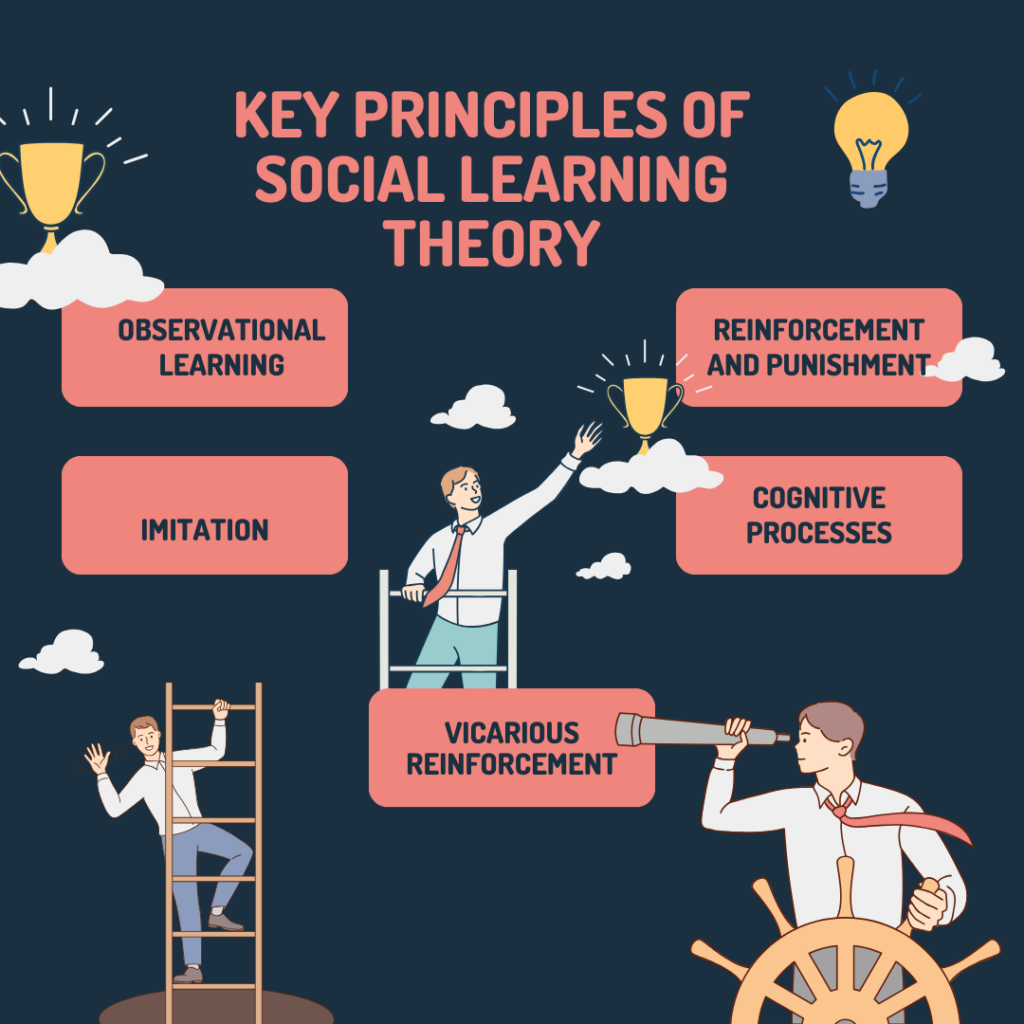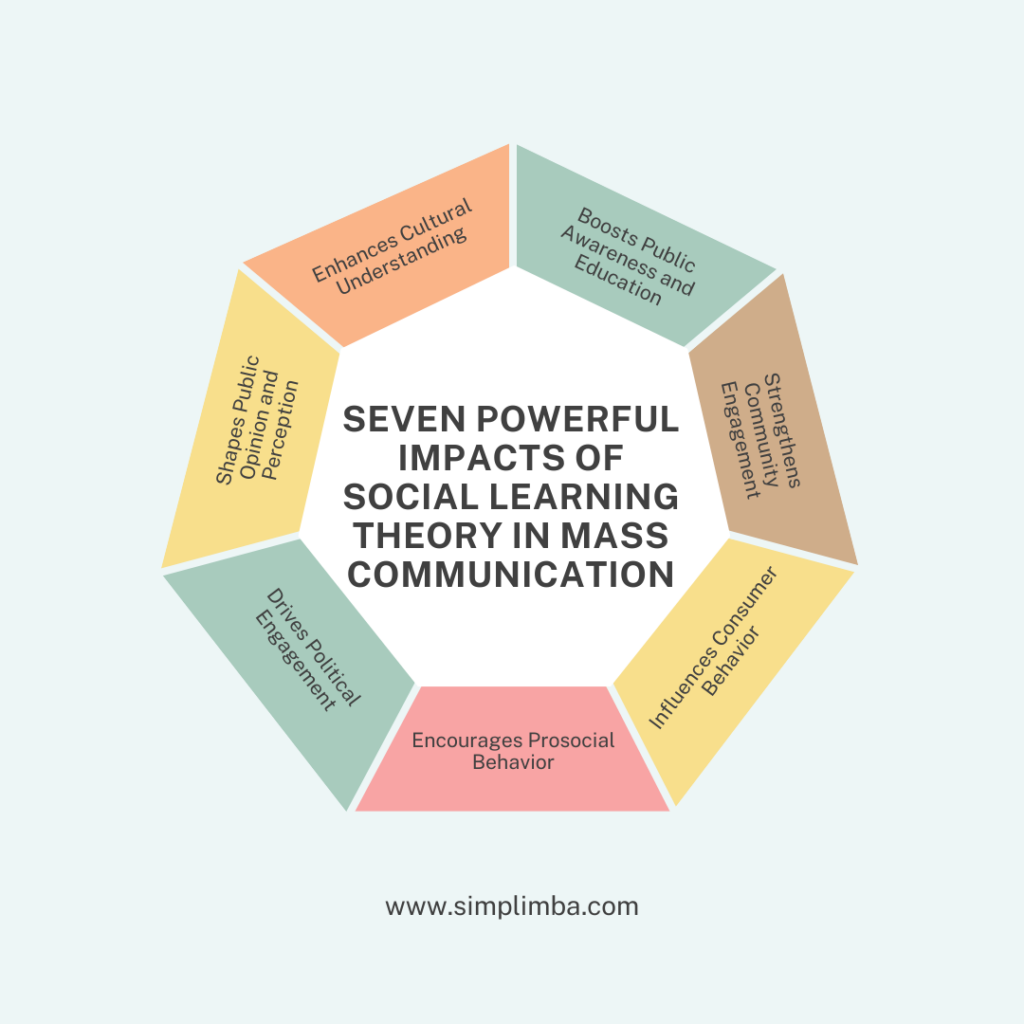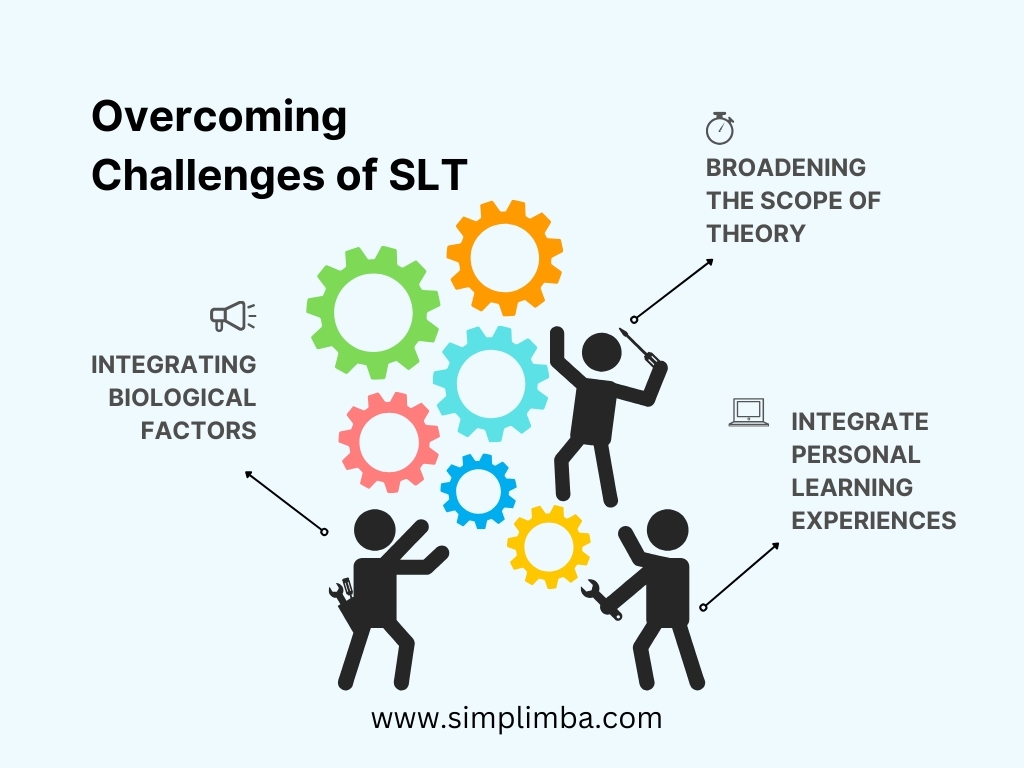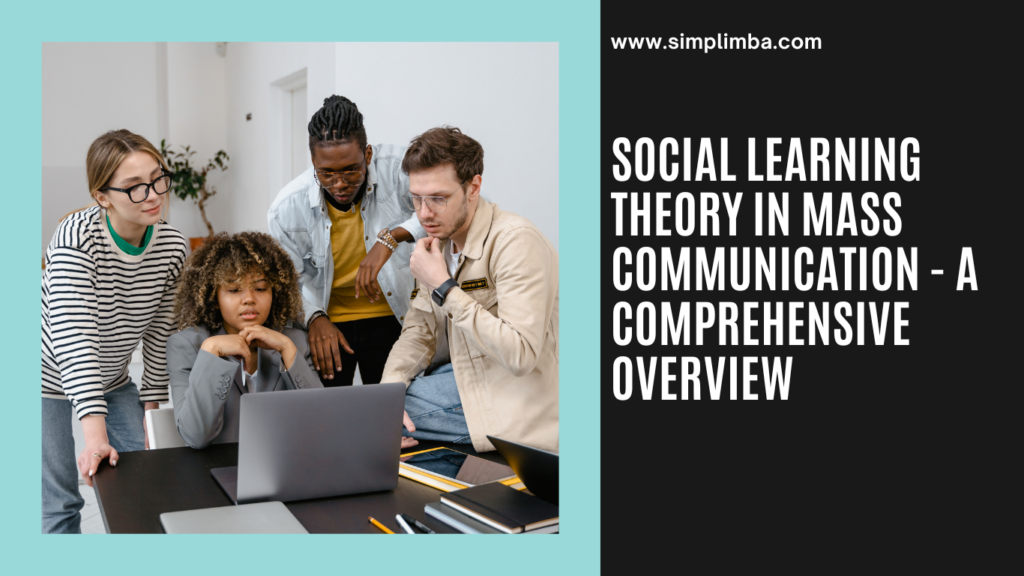Social Learning Theory, first proposed by psychologist Albert Bandura in the 1960s, posits that people learn from one another, via observation, imitation, and modeling. The theory comprises three core concepts: observational learning, inherent reinforcement, and reciprocal determinism.
Observational Learning: This is the process by which individuals learn through observing others’ behaviors and the outcomes of those behaviors. Bandura suggested that this learning occurs in four stages: attention, retention, reproduction, and motivation.
Inherent Reinforcement: Social Learning Theory suggests that we can learn by being rewarded or punished directly (known as direct reinforcement), as well as by observing someone else being rewarded or punished (vicarious reinforcement).
Reciprocal Determinism: This concept involves the mutual influence between three components – the individual, the behavior, and the environment. It suggests that while our environment shapes us, we also have the power to shape our environment.
The Role of Social Learning Theory in Mass Communication
In the context of mass communication, Social Learning Theory has been used to explain how media influences behavior. Mass communication serves as a significant source of social learning by providing models of behavior that are observed and imitated by individuals.
Media as a Source of Learning: Mass media can provide a wide range of behavioral scripts that people may observe and possibly imitate. For instance, exposure to violence on television can lead some viewers to learn aggressive attitudes and behaviors, a phenomenon well-documented in Bandura’s Bobo Doll experiments.
Media Influences Perceptions: Media not only provides models for behavior but also affects people’s perceptions of the prevalence and acceptability of behaviors. For instance, if the media frequently portrays substance use as commonplace and acceptable, audiences may come to view such behavior as the norm.
Media and Reinforcement: The media is capable of reinforcing behaviors and attitudes, either positively or negatively. The depiction of behavior consequences can influence whether an individual chooses to replicate the behavior. For instance, if a television character is shown to suffer severe consequences from drunk driving, it may deter viewers from engaging in similar behavior.
Media and Reciprocal Determinism: Mass media and its audiences engage in reciprocal determinism. While media messages can influence audience behaviors and attitudes, audience preferences can also influence the media content. This dynamic interaction further complicates the role of media in social learning.
Understanding Social Learning Theory
Key Principles of Social Learning Theory

Observational Learning: This is the fundamental concept of SLT. Observational learning suggests that individuals learn and mimic behaviors by watching others. This process involves several steps: attention, retention, reproduction, and motivation. Attention requires the individual to pay heed to the behavior being observed, retention involves remembering what has been paid attention to, reproduction is the ability to perform the behavior that the model has displayed, and motivation to reproduce behavior is influenced by the observed consequences – rewarding or punishing.
Reinforcement and Punishment: Reinforcement and punishment play a critical role in SLT. Behaviors are more likely to be repeated if they are reinforced, or rewarded, and less likely to be repeated if they are punished. Reinforcements can be positive or negative. Positive reinforcement is when a behavior is followed by a positive outcome, encouraging the behavior to be repeated. Negative reinforcement is when a behavior leads to the removal of an unpleasant outcome, which also encourages the behavior to be repeated. Punishments, on the other hand, decrease the likelihood of a behavior being repeated.
Imitation: This principle suggests that individuals are more likely to imitate models who are similar to them, who they look up to or admire, and when the behavior is within their ability to reproduce.
Cognitive Processes: SLT proposes that individuals are not merely passive recipients of information, but actively process information in their environment. This means that learning involves cognition – understanding and processing the behavior observed in others before it is imitated.
Vicarious Reinforcement: This term refers to an individual’s ability to learn from the consequences of another’s actions. If an individual observes a model being rewarded for a behavior, they are more likely to imitate and repeat that behavior.
SLT has been applied in various fields, such as education, healthcare, and psychotherapy, to promote positive behavior and discourage negative behavior. In the research context, SLT can be studied using various methods, such as observational studies, experimental studies or surveys. The data can be analyzed using statistical techniques to understand the impact of social learning on individual behavior. The findings can be published in academic journals to contribute to the existing body of knowledge on SLT and its applications in different contexts.
Real-life Examples of Social Learning via Mass Communication
An excellent example of social learning via mass communication is the influence of public service announcements (PSAs) on societal behaviors. PSAs are designed to modify public attitudes and behaviors by providing models of desirable behaviors. For instance, anti-smoking campaigns show the adverse effects of smoking, aiming to discourage the behavior. A study by Biener and McCallum-Keeler (1998) found that exposure to anti-smoking advertisements reduced smoking initiation among adolescents.
Another example can be seen in the influence of social media influencers on their followers’ behaviors. Influencers often model lifestyles, attitudes, and behaviors that their followers may adopt. Research conducted by De Veirman, Cauberghe, and Hudders (2017) found that influencer marketing can significantly affect the purchase intentions of followers, especially when there is a high level of parasocial interaction (one-sided feeling of closeness) between the influencer and the follower.
The ‘CSI Effect‘ is another example of social learning via mass communication. This term refers to the influence of crime shows on public perceptions of the legal system. Podlas (2006) conducted a study that found viewers of the CSI franchise had higher acquittal rates in cases with a lack of forensic evidence, demonstrating that these shows can shape viewers’ understanding and expectations of real-world forensic science.
Seven Powerful Impacts of Social Learning Theory in Mass Communication

Enhances Cultural Understanding
Social learning theory posits that individuals learn from observing others within their social circles. In the context of mass communication, this translates into the ability for individuals to learn about diverse cultures and practices. Through media platforms like television, radio, and the internet, diverse cultures are showcased, promoting cultural understanding and reducing prejudice. Accurate depiction of various cultures fosters respect and peaceful coexistence.
Boosts Public Awareness and Education
Mass communication is a powerful tool for disseminating information to large populations. Social learning theory emphasizes that people learn from observation. Hence, when mass communication channels broadcast educational content, it boosts public awareness about various issues. For example, public service announcements on health campaigns, environmental issues, and social injustices can significantly enhance public education and awareness.
Strengthens Community Engagement
Social learning theory underscores the significance of observational learning in shaping behavior. Mass communication can use this principle to stimulate community engagement. By showcasing stories of active community involvement and positive outcomes, individuals are more likely to participate in community activities. This has the potential to build stronger communities, enhance mutual support, and foster societal growth.
Influences Consumer Behavior
Advertisers often apply the principles of social learning theory in their strategies. By portraying their products or services as being used and enjoyed by others, they hope to influence potential customers to do the same. This indirect persuasiveness of mass communication can significantly shape consumer behavior, impacting market trends and influencing economic activity.
Social learning theory suggests that individuals are likely to replicate behaviors that they perceive as beneficial or rewarding. Mass communication has a significant role in promoting prosocial behavior by broadcasting content that shows the positive consequences of such behavior. For instance, by illustrating the benefits of recycling, the media can foster a culture of environmentally friendly practices.
Drives Political Engagement
The mass media is a key player in political communication, influencing public opinion and driving political engagement. By observing political discussions, debates, and campaigns, individuals can learn about the political landscape and the importance of their participation in democratic processes. This knowledge can lead to more active civic engagement, ensuring a vibrant democracy.
Shapes Public Opinion and Perception
Social learning theory and mass communication together play a vital role in shaping public opinion. Media often provides the “social models” from which individuals learn and form opinions. By carefully selecting what news to present and how to present it, mass media can influence public perception on a wide range of issues. This highlights the power of mass communication in shaping societal norms and values.
Case Studies of Social Learning Theory in Mass Communication
Case Study 1: Social Learning through News Broadcasting
News broadcasting plays a pivotal role in influencing societal norms and behaviors, acting as a significant source of social learning. The first step in investigating this claim would be to identify a suitable sample of news broadcasts and a corresponding audience from a defined period. For this study, we could take a year’s worth of broadcasts from three leading news channels and a sample audience of 1000 regular viewers.
Then, we would conduct a content analysis of the broadcasts, identifying recurring themes, tones, and framing strategies. We would specifically focus on how news stories are presented and what behaviors or attitudes they might be implicitly or explicitly promoting.
As part of the audience study, we would measure changes in attitudes and behaviors aligned with the themes identified in the content analysis (using pre and post-surveys, interviews, etc.). For instance, if health-related stories were frequently framed in a fear-inducing manner, we would examine if viewers exhibited increased health anxiety or altered health behaviors over the study period.
Case Study 2: Social Learning via Social Media Platforms
Social media has become an integral part of our lives, acting as both a communication channel and an informal education space. We would investigate social learning on social media platforms by first identifying popular social topics, such as climate change, racial justice, or mental health.
For each topic, we would conduct a network analysis on popular social media platforms, such as Twitter or Facebook, to identify key influencers and common discourse themes. For instance, we might use machine learning algorithms to analyze the frequency and sentiment of related hashtags.
We would then survey or interview social media users to measure their knowledge and attitudes towards these topics, comparing these metrics before and after exposure to related social media content. This analysis would help us understand the extent to which social learning takes place via these platforms and what factors might enhance or inhibit this process.
Case Study 3: Social Learning through Advertisement Campaigns
Many advertisement campaigns aim to change consumer behavior, making them an interesting avenue for studying social learning. For this case study, we would select a variety of recent, high-profile advertisement campaigns that sought to promote or discourage specific behaviors, such as anti-smoking campaigns or fitness promotion ads.
We would conduct a semiotic analysis of these ads to understand the messages they convey and the techniques used to make these messages persuasive. This analysis would consider elements like language, imagery, music, and narrative structure.
Then, through surveys or focus groups, we would measure audience engagement with these ads and any resulting behavior change. For instance, we might ask participants if they remember specific ads, what they took away from them, and if they made any related changes to their behavior.
Challenges and Critiques of Social Learning Theory in Mass Communication
Oversimplification of Human Behaviour: The Social Learning Theory (SLT) has been criticized for its over-simplification of human behavior. According to the theory, individuals learn behaviors by observing others and replicating their actions, which does not take into account the complexities of human cognitive processes including emotions, motivations, and individual personality differences.
Lack of Consideration for Biological Factors: Many critics argue that SLT disregards the role of biological factors in shaping behavior. It assumes that all learning is a result of environmental factors and that nature has no role in this process. This can be a significant limitation as it doesn’t fully account for the role of genetics in shaping individual behavior and personality.
Ignoring the Influence of Personal Experiences: The theory focuses significantly on learning from other people in a social environment. However, it fails to account adequately for personal experiences and individual learning that occur outside the influence of social observation.
How to Overcome Challenges of Social Learning Theory

Broadening the Scope of the Theory: In response to the criticism of oversimplification, scholars have been advocating for a broader interpretation of the SLT. This broader perspective includes the consideration of cognitive processes and individual factors that influence the learning process. Such an approach would do justice to the intricate nature of human behavior.
Integrating Biological Factors: To address the criticism about the lack of consideration for biological factors, it is suggested that the SLT should be integrated with biological and genetic theories. An interdisciplinary approach that includes elements of biology, psychology, and sociology can provide a more comprehensive understanding of human behavior.
Incorporating Personal Experiences: To address the criticism related to personal experiences, future research needs to focus on the role of personal experiences in shaping behaviors. Observational learning is not the only form of learning, and the theory should incorporate other forms of learning like trial and error, insight learning, etc.
Samrat is a Delhi-based MBA from the Indian Institute of Management. He is a Strategy, AI, and Marketing Enthusiast and passionately writes about core and emerging topics in Management studies. Reach out to his LinkedIn for a discussion or follow his Quora Page

